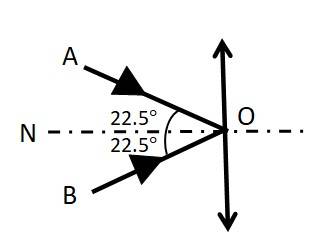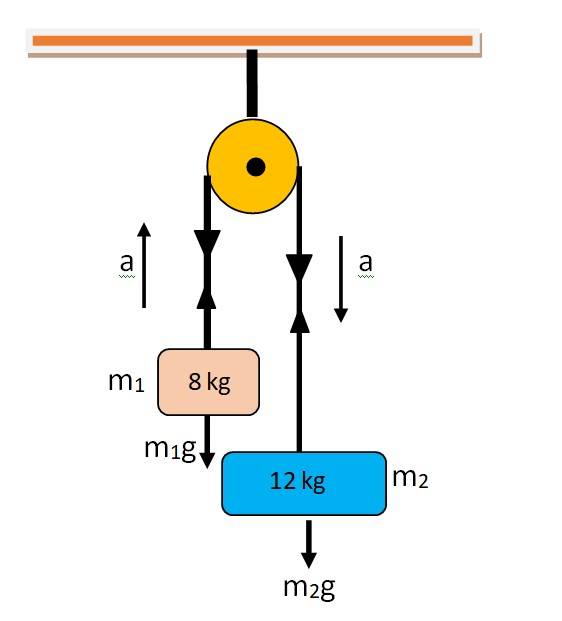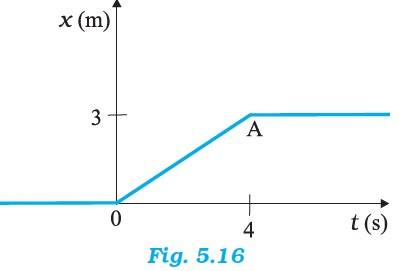Laws of Motion
Get insights from 109 questions on Laws of Motion, answered by students, alumni, and experts. You may also ask and answer any question you like about Laws of Motion
Follow Ask QuestionQuestions
Discussions
Active Users
Followers
New answer posted
6 months agoContributor-Level 10
Mass of the stone, m = 0.25 kg
Radius of the circular path = 1.5 m
Speed = 40 rev/min = 0.67 rev/s
Angular velocity, = 2 = 2 = 4.19 rev/s
The tension of the string, T = m r = 0.25 = 6.59 N
Maximum tension of the string, = 200 N
From the equation = /r, =
= 200 /0.25
= 34.64 m/s
New answer posted
6 months agoContributor-Level 10

Velocity of the ball, u = 54 km/h = 15 m/s, mass of the ball, m = 0.15 kg
The ball is deflected back such that the included angle is 45
The initial momentum of the ball, along the direction of NO is = mu = 0.15 15 cos 22.5 = 2.0787 kg-m/s
The final momentum of the ball = mu along ON
Impulse = change of momentum = mu - (-mu ) = 2mu = 4.16 kg-m/s
New answer posted
6 months agoContributor-Level 10
The mass of the shell, m = 0.020 kg
The mass of the gun, M = 100 kg
Speed of the shell, v = 80 m/s
The initial velocity of the shell and the gun = 0, so the initial momentum of the system = 0
Applying the law of conservation of momentum, the initial momentum = final momentum
0 = mv – MV, where V is the recoil speed of the gun
V = mv/M = 0.020 80 / 100 = 0.016 m/s
New answer posted
6 months agoContributor-Level 10
Mass of each ball, m = 0.05 kg
Initial velocity of each ball, u = 6 m/s
The initial momentum of each ball before collision = mu = 0.05 x 6 = 0.3 kg-m/s
After the collision, the ball changes the direction of motion without the change in magnitude of the velocity, so
The final momentum after collision of the first ball = - 0.05 6 = - 0.3 kg-m/s
The final momentum after collision of the second ball = 0.05 6 = 0.3 kg-m/s
Impulse imparted to the first ball = (-0.3) – (0.3) = -0.6 kg-m/s
Impulse imparted to the second ball = (0.3) – (-0.3) = 0.6 kg-m/s
The two impulses are opposite in direction.
New answer posted
6 months agoContributor-Level 10
Let m1 & m2 be the masses of two nuclei and m be the mass of the main nuclei.
m = m1 + m2
If and be the corresponding velocities of two nuclei then total linear momentum after disintegration = m1 + m2
Since at the initial stage, mass nuclei was at rest, so the initial linear momentum = 0
From the law of conservation we know
Total linear momentum before disintegration = total momentum after disintegration
0 = m1 + m2
= - m2 / m1
-ve sign indicates that the two velocities and are in opposite direction
New answer posted
6 months agoContributor-Level 10

Given, small mass, m1 = 8 kg. bigger mass, m2 = 12 kg
Let T be the tension in the string
The heavier mass will go downward and the lighter mass will go upward.
Applying Newton's 2nd law,
For mass m1, T –m1g = m1a …… (1)
For mass m2, m2g – T = m2a……. (2)
Adding (1) & (2), we get
(m2 - m1) g = (m1 + m2) a
a = (m2 - m1) g/ (m1 + m2) = 4 = 2 m/s
From equation (1), we get, T = 8 (2 +10) = 96 N
New answer posted
6 months agoContributor-Level 10


Mass of the body A, m1 = 10 kg, mass of the body B, m2 = 20 kg, Horizontal force = 600 N
Total mass of the system, m =m1 + m2 = 30 kg
From the relation F = ma, we get a = 600 / 30 = 20 m/s2
(i) When the force is applied on A
F – T = m1a or T = F - m1a = 600 – 10 = 400 N
(ii) When the force is applied on B
F-T = m2 a, T = F - m2 a = 600 – 20 N
New answer posted
6 months agoContributor-Level 10
(a) For t<0, the distance covered by the particle x is zero. Hence force on the particle is zero. For t>4s, the particle is moving at a constant distance, so the force will be zero. For 0
(b) Impulse is given by the equation, Impulse = total change of momentum. At t = 0, u = 0, v = distance / time = ¾ = 0.75 m/s
Impulse = 4 (0.75-0) kg-m/s = 3 kg-m/s
Impulse at t=4, u = 0.75, v = 0, Impulse = 4 (0-0.75) = -3 kgm/s
New answer posted
6 months agoContributor-Level 10
The mass of the man, m = 70 kg, g = 10 m/s2, Let W be the reading on the weighing scale
(a) When the lift is moving upward with uniform speed of 10 m/s, the acceleration = 0
The value of W is given by W = mg = 70 = 700 N
(b) The lift is moving downward with acceleration, a = 5m/s2 Using Newton's 2nd law of motion, the equation of motion can be written as W + MA = mg or W = m (g-a)
= 70 (10-5) = 350 N
(c) The lift is moving upward with acceleration of a =5m/s2 . Using Newton's 2nd law
W = m (g+a) = 70 = 1050 N
(d) If the lift mechanism fails, the lift will come down with acceleration due
New answer posted
6 months agoContributor-Level 10
(a) When the bob is at extreme position, the velocity at that point is zero. If the string is cut at that location, the bob will fall because of its own weight
(b) At the mean position, if the string is cut, due to horizontal velocity, the bob will act like a projectile and will fall on the ground, following a parabolic path.
Taking an Exam? Selecting a College?
Get authentic answers from experts, students and alumni that you won't find anywhere else
Sign Up on ShikshaOn Shiksha, get access to
- 65k Colleges
- 1.2k Exams
- 679k Reviews
- 1800k Answers

